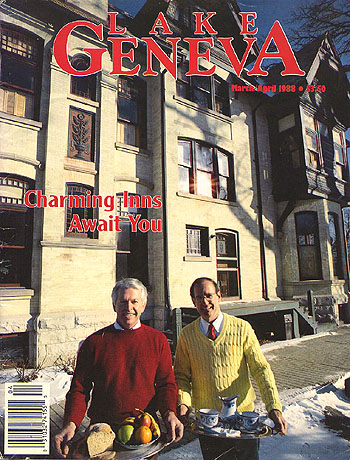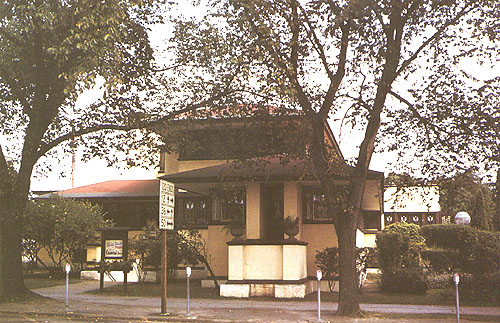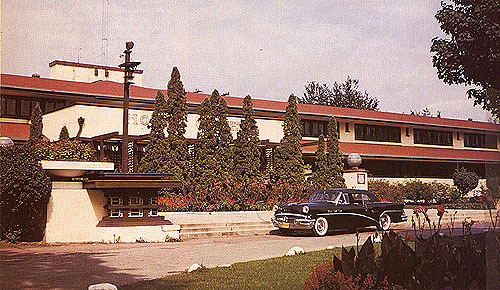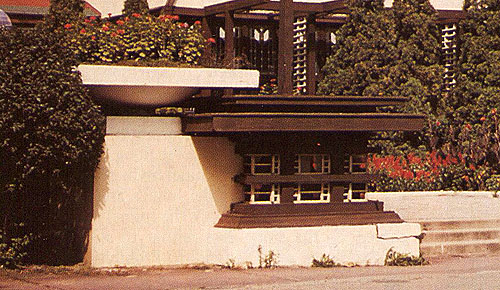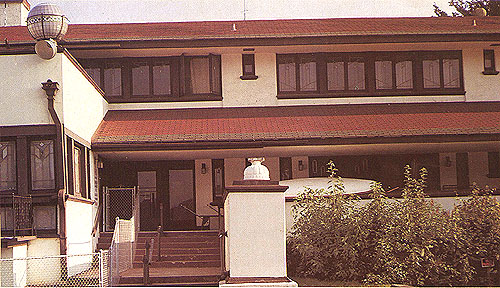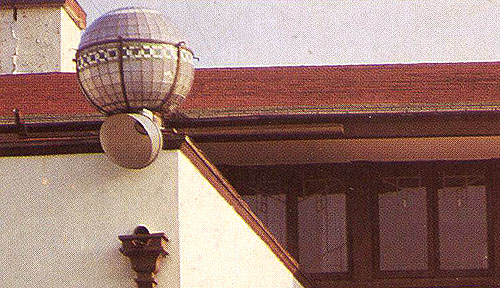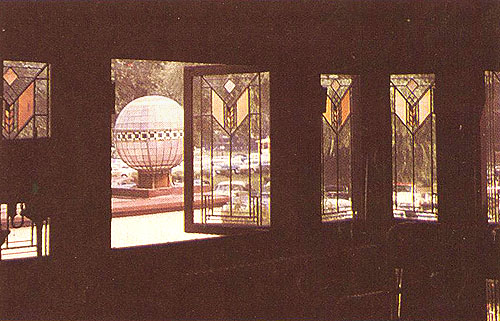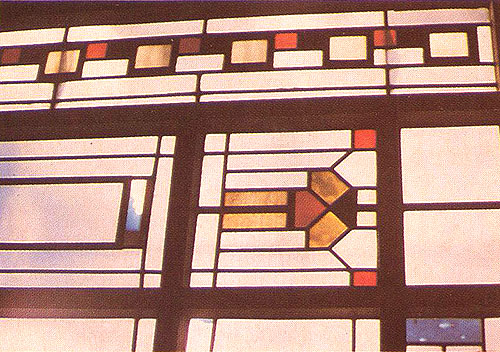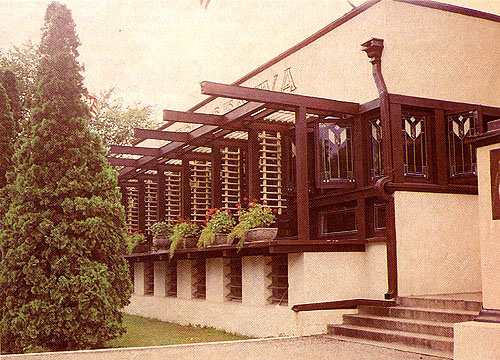LAKE GENEVA MAGAZINE
YEAR TITLE AUTHOR DESCRIPTION PAGES ST# 1988 Lake Geneva Magazine - March/April 1988 (Published Bimonthly by R. James Beam, dba Lake Geneva Magazine, Lake Geneva, Wisconsin) 1, 3, 4) Schaefer, Ted 1) “No Rooms Available. Once-Famous Lake Geneva Hotel Designed by Frank Lloyd Wright Checks out of Local History.” “The lobby - roofed by a stained glass skylight and lit by handing lamps designed by Wright - included a alcove with a massive open wood-burning fireplace between built-in upholstered benches. All his life Wright loved fireplaces and according to some Wright scholars, the Lake Geneva Hotel fireplace, with its arching brick sunburst pattern, was one of his best.” See Excerpts. Pp 6-13 1988.42.0209 2) Meehan, Patrick J. 2) “Origins of the Lake Geneva Hotel.” 3) More Wright Designs Built Near Delavan Lake 4) Johnson Wax Building Showcases Wright’s Unique Style. Includes thirteen photographs and one Illustration. Original cover price $3.50. 8.4 x 10.8. (Digital version)
HOME ARTIFACTS AUDIO BOOKS PERIODICALS PHOTOS POSTCARDS POSTERS STAMPS STUDIES ASSISTING COLLECTING
Lake Geneva Hotel, Lake Geneva, WI (1911) (S.171)
(Note, the Lake Geneva Magazine is not longer being publishing, I have
copied excerpts of the text, but give all credits available.)Lake Geneva Magazine - March/April 1988
Published Bimonthly by R. James Beam, dba Lake Geneva Magazine, Lake Geneva, Wisconsin
Excerpts from:
“No Rooms Available”, Pp 6-13
By Ted Schaefer http://www.pw.org/content/ted_schaefer_1No Rooms Available: Once-Famous Lake Geneva Hotel Designed by Frank Lloyd Wright Checks out of Local History.
...late summer of 1912 - a stunningly different but equally memorable (as the Whiting House) resort hotel was occupying spot and officially opened for diners and overnight guests. Wright’s long, low, cream- colored two-story building with its red cantilevered roofs overhanging it’s banks of leaded glass windows stretched from Broad Street to Center Street, sending terraces, gardens, and lawn toward the lakefront. The Lake Geneva Hotel’s interior was just as remarkable. The spacious dining room gleamed under a lighted, multicolored art-glass ceiling, its south side carrying a large outdoor terrace. According to local newspaper accounts, “The dining room, furnished with brown fiber rush chairs, has an inviting appearance. The lobby and loggia are also furnished in rush fiber in green with green leather cushions for the chairs, divans and settees. Green and brown are the prevailing tones throughout the hotel.”
‘The lobby - roofed by a stained glass skylight and lit by handing lamps designed by Wright - included a alcove with a massive open wood-burning fireplace between built-in upholstered benches. All his life Wright loved fireplaces and according to some Wright scholars, the Lake Geneva Hotel fireplace, with its arching brick sunburst pattern, was one of his best.’ In its early days the hotel and its dining room did a booming business. State one newspaper report, “On Saturday over fifty applications for rooms had to be turned down, while the restaurant has been serving almost the limit of dinner.” Current Lake Geneva resident Einar Anderson, 94, remembered the hotel restaurant ... “The prices were high because it was the best hotel in town, and it catered to the people who had money.”
...Despite its aura of prosperity, however, the hotel - always alarmingly expensive to operate and maintain - soon showed signs of financial stress: from 1912 to 1915, for instance, it went through three different pair of owners. At a March 1914 sheriff’s sale it sold for a mere $57,780.83. (A second foreclosure sale in February 1939 gave the resort to the Schroeder hotel organization for $42,000.)
...A mythic character easily earned that appellation was the hotel’s most colorful, most popular, most controversial proprietor, Hobart “Hobe” Hermansen, who ran the hospice from 1941 to 1966.
...It was during the Hermansen reign that Frank Lloyd Wright would occasionally visit his old hotel for lunch or dinner, or even for an overnight stay, according to O’Brien and Hermansen’s nephew, Allen. Wright and his wife, Olgivanna, were good friends with the P.K. Wrigleys and usually stayed on their estate when the came to Lake Geneva, but a look at the building was sometimes a part of the itinerary.
...’By the mid-1960s it was increasingly evident the Lake Geneva Hotel was dying. The windows leaked. The water stained wallpaper was peeling. Grime gathered. Fissures appeared in the stucco. The front terrace grew concrete block walls and an ugly kidney-shaped swimming pool.' ...Hermanson sold the hotel to the White River Corporation in 1962, foreclosed on the new owner in 1965, then sold it back to them again in 1966.
... When plans were announced to raze the hotel... A committee of architectural heritage elicited promises from the White River Corporation that the lobby would be carefully dismantled - fireplace, benches, oak beams, skylight, leaded glass casement windows - so it could be reassembled someday in a university museum.
...The Wright-designed artifacts, meanwhile were being sold, given away, and stolen.
...Lynn Johnson... a former Wright apprentice at Taliesin and currently an architect/designer with Thompson Associates... studied and photographed the Lake Geneva Hotel in 1959-60, and found it quite impressive. “I always thought it was quite dramatic... The most sticking thing about it was the overhang on that veranda along the lower rooms - I think it was ten- or twelve-foot overhang, which was really extraordinary for the time.
...Milwaukee architect Dan Thompson said, One of my professors at Iowa State actually took his summer vacation in Lake Geneva just to stay in the building. He felt the most notable thing about it - other than it was a Wright building - was the fact that it was the forerunner of the modern motor hotel. It was considered the prototype, really: the first of an entire trend catering to the motoring public.” Remembered Thompson, who grew up in Fontana, “As a kid, this building didn’t hit me as a building, it hit me as a place, a really interesting place, because the building was married to the site so well.
“And it just fit - it felt as though it has been there forever.”
Photographs by Lynn Anderson and Alyn W. Hess. Captions by Ted Schaefer. (Notes: When indicated are added by Douglas Steiner) The west side of the hotel on Broad Street housed an elegant first floor restaurant and a basement tavern where gamblers convened. Photograph by Lynn Anderson. The hotel in the late 1950s still boasted lush grounds and gardens surrounded its front driveway. Some architects consider it the prototype of the modern motel. Photograph by Lynn Anderson. (Note: Al Hermansen’s new 1956 Buick Special convertible is pictured in this photograph.) Detail: (Note: I had the opportunity to speak with Al Hermansen, and he confirmed that the decorative “Light Pole” did indeed contains lights. “We had a heck of a time changing the lights inside the base.”)
In the last days the Lake Geneva Hotel, stripped of its ornaments and trellises, fell into disrepair, with even its bushes untrimmed, its only profitable feature was a swinging singles bar called Snoopy’s. Photograph by Alyn W. Hess. (Additional information about the Hotel Geneva.) Detail: (Note: These glass globe lights did not appear in images until sometime around 1919-1921. There were two sizes, a smaller size that sat upon the outside corners of the lobby, pictured, and a larger globe that sat top the pedestals on either side of the entrance, where an upside vase sits in the above image. Al Hermansen said that every winter the globes were stored indoors. They would joke, “It’s time to take Frank’s balls inside now.”) The hotel lobby’s banks of leaded-glass casement windows opened to a view of the front terrace and the lake. Photograph by Lynn Anderson. (The big outside globe was not an original Wright artifact.) Roofing the front lobby and drenching it with multicolored light was a stained glass skylight designed by Wright himself. Photograph by Lynn Anderson. Oak beams and trellises and flowers in the window-pots gave a warm rustic touch to the front entrance of the famous hotel. Photograph by Lynn Anderson. The hotel was a difficult building to demolish, but it finally tumbled down in January 1970. Two years later a concrete high-rise condominium took its place. Photograph by Lynn Anderson.
